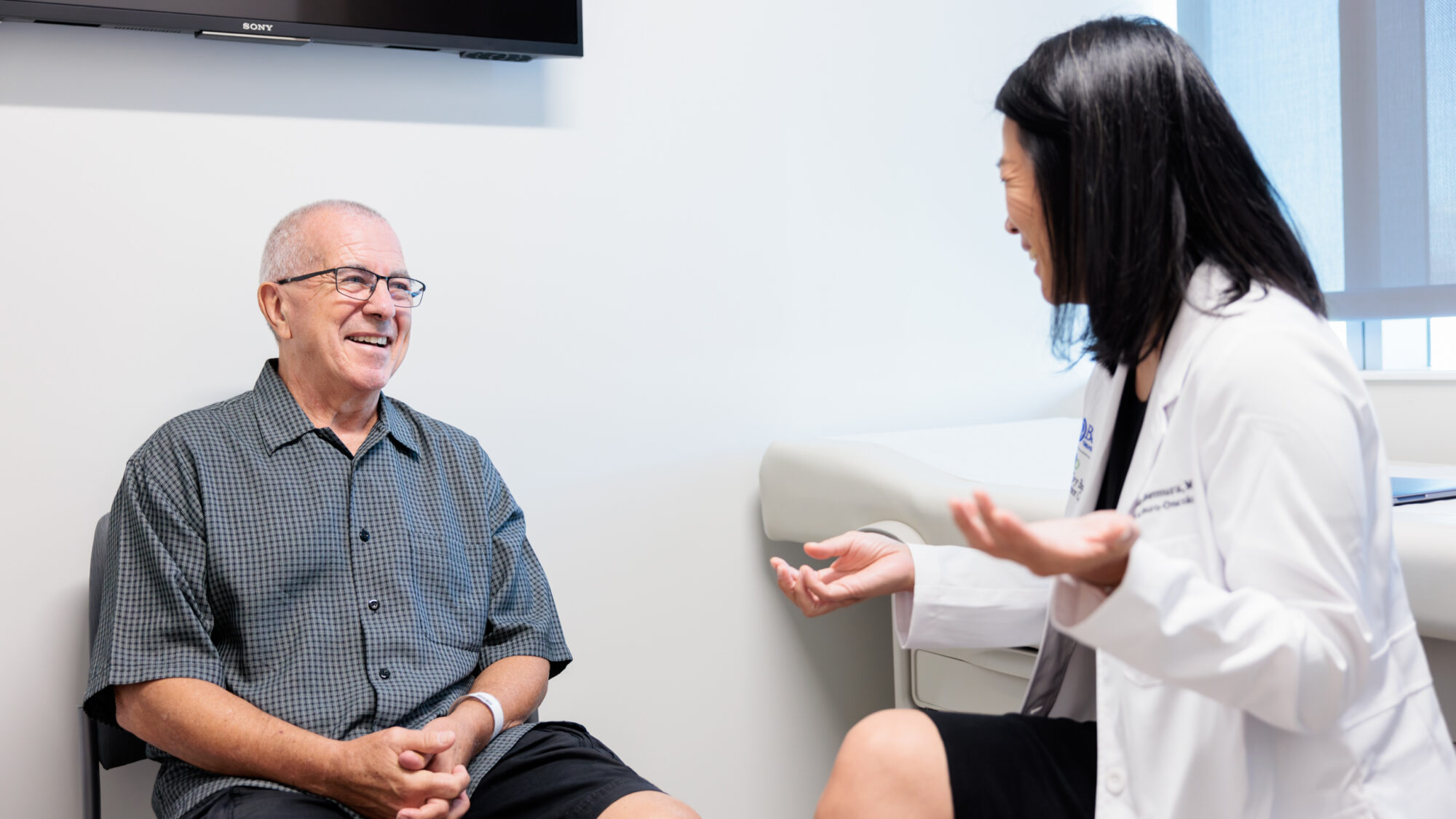
Systemic Chemotherapy
Overview
Systemic chemotherapy, most commonly known as chemotherapy or simply “chemo,” is a type of cancer treatment that uses powerful drugs to target and kill cancer cells throughout the body. Doctors typically administer these drugs intravenously or orally, allowing them to enter the bloodstream and reach cancer cells wherever they grow.
Oncologists use chemotherapy to treat widespread cancers or cancers with a high risk of spreading. Cancer cells are particularly vulnerable to chemotherapy drugs because they tend to divide and grow more quickly than other cells.
Chemotherapy is a highly adaptable treatment, meaning treatment plans can target specific cancer types, stages, and even genetic profiles. This level of customization also means chemotherapy can serve multiple roles, whether it’s as a primary treatment or done in addition to surgery or radiation.

How Systemic Chemotherapy Works
Chemotherapy drugs exploit the fact that cancer cells divide rapidly. By blocking key parts of cell division, chemotherapy causes cancer cells to accumulate damage, leading to cell death. Different chemotherapy drugs work in different ways to disrupt cell division—for example, alkylating agents attach to DNA and prevent the cell from replicating, while antimetabolites mimic natural substances in cells, interfering with DNA and RNA synthesis and preventing the cancer cells from dividing.
While chemotherapy targets these rapidly dividing cancer cells, it also can potentially affect healthy cells that divide quickly, such as hair follicles, digestive tract cells, and bone marrow cells, depending on the chemotherapy used. This is why side effects like hair loss, fatigue, and nausea are so common with some but not all chemotherapy. Oncologists frequently use supportive medications to help prevent and treat side effects during treatment. That said, unlike cancer cells, most healthy cells can repair themselves and recover after completion of chemotherapy.
Systemic chemotherapy is most often administered intravenously (IV) or orally. When given through an IV, the drug enters the bloodstream directly, while oral chemotherapy is absorbed through the digestive system. Once in the bloodstream, chemotherapy drugs circulate and infiltrate cancer cells throughout the body.
Different chemotherapy drugs are often combined to increase effectiveness. The type and length of your chemotherapy treatment will depend on the cancer being treated as well as your overall health before and during therapy. Treatment sessions can range from minutes to multiple hours. Sometimes, a continuous infusion is needed, which can span several days.
Chemotherapy features periods of active treatment followed by periods of rest. This schedule allows time for normal cells to recover between doses while continuing to target cancer cells. Typically, multiple cycles are needed to accumulate enough damage to cancer cells and reduce the chance of recurrence.
What is systemic chemotherapy used to treat?
Systemic chemotherapy plays a crucial role in controlling cancer spread and in improving the prognosis in aggressive or advanced cancer cases.

What is systemic chemotherapy used to treat?
Systemic chemotherapy plays a crucial role in controlling cancer spread and in improving the prognosis in aggressive or advanced cancer cases.
It’s a recommended treatment for a long list of cancers, including:
- Brain and spine cancers: Various chemotherapies are used to treat and prevent the growth of primary brain tumors, such as astrocytomas, glioblastomas, oligodendrogliomas, and medulloblastomas. Depending on the tumor type, chemotherapy may be used concurrently with radiation or by itself.
- Blood and bone marrow cancers: Chemotherapy is particularly effective in treating cancers that circulate through the bloodstream or originate in bone marrow, like leukemia, lymphoma, and multiple myeloma.
- Breast cancer: Physicians often use chemotherapy in early-stage breast cancer as a pre-surgery or post-surgery therapy, known as neoadjuvant or adjuvant therapy. In metastatic breast cancer, or breast cancer that has spread, chemotherapy can both manage the cancer and help relieve symptoms.
- Lung cancer: Small cell lung cancer (SCLC) responds well to chemotherapy because it’s aggressive and spreads quickly to other parts of the body. For non-small cell lung cancer (NSCLC), chemotherapy is used when surgery alone isn’t sufficient.
- Colorectal cancer: Chemotherapy is commonly used for advanced or metastatic colorectal cancer to reduce recurrence risk.
- Pancreatic cancer: Due to aggressiveness and its location, pancreatic cancer can be challenging to treat. Chemotherapy can help slow the spread and improve overall prognosis, especially when surgery alone isn’t successful.
- Ovarian cancer: Whether it’s administered after surgery or given as a primary treatment, chemotherapy has a strong history of effectively treating ovarian cancers.
- Bladder cancer: Chemotherapy has an important place in treating bladder cancers and can be given before surgery to shrink a tumor or after surgery to prevent recurrence.
- Esophageal and stomach cancers: Commonly used for cancers of the esophagus and stomach, chemotherapy can be used to reduce tumor size before surgery or after a late-stage diagnosis.
- Prostate cancer: While prostate cancer often responds to hormone therapy alone, chemotherapy can be used in cases of advanced or hormone-resistant prostate cancer.
- Testicular cancer: Testicular cancer responds very well to chemotherapy, particularly in advanced stages or if it’s metastasized. Testicular cancer is one of the most treatable cancers with chemotherapy, with a 95 percent survival rate.
- Sarcomas: Chemotherapy is frequently part of the treatment plan for non–sarcomas and soft tissue sarcomas, especially for those that have spread or cannot be entirely removed via surgery.
Even when cancer cannot be cured by systemic chemotherapy, the treatment can continue to relieve symptoms and prolong the overall quality of life.
Common Questions
How common is systemic chemotherapy?
Systemic chemotherapy is the most commonly used cancer treatment in the U.S. after surgery. The National Cancer Institute estimates that millions of chemotherapy infusions are administered annually, with breast, lung, colorectal, and blood cancers being among the most frequently treated cases.
Approximately 50 to 60 percent of cancer patients receive some form of chemotherapy during their cancer treatment. It’s especially common for advanced or metastatic cancers. It is often combined with surgery and other therapies, like radiation, targeted therapy, and immunotherapy
What are the side effects of systemic chemotherapy?
Because systemic chemotherapy affects both cancer cells and healthy cells, it’s normal to experience a wide range of side effects. Your specific side effects will depend on the type of chemotherapy used, your exact dosage, your treatment duration, and your overall health. Oncologists have many supportive treatments to help prevent and treat potential side effects.
If you or someone you know are undergoing chemotherapy, you may experience any combination of these symptoms:
- Nausea and vomiting: Chemotherapy often irritates the stomach lining and triggers the part of the brain involved with the sensation of nausea and the vomiting reflex. This same nausea can also lead to loss of appetite, taste changes, and mouth sores. Anti-nausea medications can help manage this side effect.
- Digestion and bowel upset: Because chemotherapy can disrupt the digestive system, diarrhea or constipation are frequently reported.
- Hair loss: Many chemotherapy drugs target fast-growing cells, including hair follicles, resulting in hair loss on the scalp and other body areas.
- Skin and nail changes: Skin may become dry, itchy, or sensitive, or you may develop rashes or changes in skin color. Your nails can also become brittle or discolored or, in severe cases, lift off the nail bed.
- Anemia: Low red blood cell counts are defined as anemia, which can lead to symptoms like fatigue, weakness, and shortness of breath.
- Low white blood cell counts: Chemotherapy can reduce the number of white blood cells (a condition called leukopenia), which can increase the chance of infections. Sometimes, medications are used to increase the number of white blood cells after chemotherapy.
- Fatigue: Fatigue is one of the most common side effects of chemotherapy. It can be persistent and may result from anemia, immune response, or the body’s effort to recover from treatment.
- Brain fog: Memory problems, difficulty concentrating, or a general “foggy” feeling, colloquially known as “chemo brain,” can occur. This is often temporary but may persist for some chemotherapy patients.
- Peripheral neuropathy: Some chemotherapy drugs can cause nerve damage, leading to tingling, numbness, or pain in the hands and feet. This side effect is usually temporary but can be long-term in rare cases.
- Easy bruising or bleeding: Reduced platelet counts make it harder for blood to clot, leading to an increased risk of bruising and bleeding.
- Mood changes: The emotional impact of a treatment like chemotherapy, along with the physical discomfort, can lead to feelings of anxiety, depression, and stress. Fatigue, anxiety, or discomfort from side effects can also affect sleep, compounding fatigue and contributing to mental well-being.
- Menstrual changes: Women may experience irregular periods, hot flashes, and temporary or permanent chemotherapy-induced menopause. This dramatic hormonal shift can bring about a multitude of additional symptoms, such as increased brain fog, fatigue, mood changes, depression, anxiety, weight gain, hot flashes, night sweats, changes to sex drive, and more.
- Fertility issues: Chemotherapy can affect fertility in both women and men, either temporarily or permanently. Consequently, fertility preservation options like egg freezing or sperm banking will often be discussed before starting chemotherapy.
While these side effects are most often temporary, it’s vital for you to report them to your healthcare team. They can be managed in several ways, including pain relief, anti-nausea drugs, growth factors for blood cells, and other supportive treatments to improve comfort.
What are the risks of systemic chemotherapy?
Because chemotherapy reduces white blood cell counts, your immune system can weaken and increase your risk of infection during treatment and several months afterward.
Certain chemotherapy drugs may cause heart, lung, liver, or kidney damage, particularly with high doses or prolonged use. Monitoring for signs of cardiovascular or respiratory issues and organ function will be essential in these cases.
Although rare, some types of chemotherapy drugs can slightly increase your risk of developing secondary cancer after treatment ends. Cancer cells can also develop resistance to chemotherapy over time, especially if exposed to only one type of drug. However, multi-drug regimens and combination therapy can help counteract this and improve treatment efficacy.
Systemic chemotherapy has risks, but these are weighed against its benefits. For many cancer patients, chemotherapy is an essential part of treatment.
What kind of results can I expect with systemic chemotherapy?
The success rate of systemic chemotherapy will depend on several factors, like your cancer’s stage or grade, the specific chemotherapy drugs being used, and your overall health. Even with the same type and stage of cancer, individuals can respond very differently to chemotherapy—variables like genetics, tumor specifics, age, and general health will influence how well you respond.
It’s essential to have an open conversation with your trusted oncology team to understand the goals of chemotherapy for your specific situation and to set realistic expectations. Your oncologist’s goal is to choose the treatment that offers you the best outcome while considering your quality of life and preferences. Your care team will regularly assess your chemotherapy results through imaging studies and blood tests to monitor your response and make adjustments as needed.
For cancers where chemotherapy has a high efficacy rate, prolonged cancer-free intervals and long-term survival can occur. In many cases, systemic chemotherapy helps prevent cancer from returning by eliminating undetected cancer cells that may have spread to other parts of the body.














